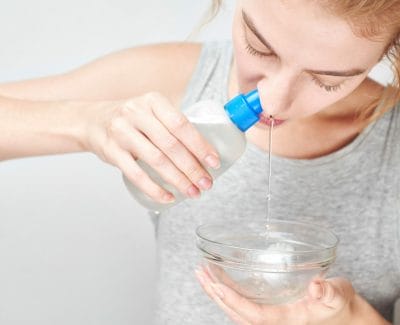Introduction
In medical terms, to irrigate means to wash. Nasal irrigation is an ancient technique based on early homeopathic and yogic practices. A salt water solution (saline) is prepared and used to wash the nasal cavity. Recently, doctors have begun to study the technique. The aim is to see how well irrigations (or rinses) work and when they should be used. Thus far, nasal rinses are demonstrated to be beneficial, safe, and well tolerated by patients. However, some questions remain unanswered.
Efficacy
Preparing and applying nasal rinses requires a significant amount of time and energy. For this reason, many researchers have asked whether there is a real benefit. A review of eight high quality research studies concluded that salt water nasal rinses are helpful to patients. While rinses help to clear the nose of mucus, they may also help to reduce inflammation. This may result from the removal of small particles, bacteria, and viruses which can cause allergy and inflammation.
Delivery Devices and Head Position
The goal of rinsing is to cleanse the entire nose, however, not all irrigation techniques can achieve this. Doctors have been studying how best to irrigate the nose using several methods or devices. Studies have shown that regardless of the specific device, it is the volume that is important. Higher volumes seem to lead to the best coverage of the nasal lining. When looking at improvement in patient symptoms, high volume nasal rinses have also been shown to be better. Sinus surgery does lead to better delivery into the sinus cavities. Further, following sinus surgery, high volume devices still work better than nebulizers.
Head position during nasal irrigation may also have an impact on delivery. Placing the head down can help the rinse get to the top of the nose and the frontal (forehead) sinus. Similarly, orienting the nose to the ceiling can help the rinse reach the back of the sinuses (sphenoid sinus).
Saline Concentration
Most physicians suggest using concentrations of saline which are the same as in the body. This is called isotonic. The benefits of higher saline concentrations (hypertonic) have also been studied in adults and children. While some benefits have been reported with hypertonic saline, side effects may occur. Patients may experience increased nasal congestion and swelling due to irritation from the high salt content. Multiple companies offer premixed salt packets which are convenient and relatively inexpensive. However, patients may elect to make their own saline at home. A common recipe is 2-3 teaspoons of iodine free salt, 1/4-1/2 teaspoons of baking soda and 1 liter of sterile water.
Bottle Contamination
Because nasal rinses are commonly used to treat infection, cleanliness is very important. Rinse bottles can contaminate the nose if not cleaned properly. Fortunately, microwave safe irrigation bottles are available and inexpensive. Therefore, this method of sterilization, along with frequent bottle exchange, is currently recommended. Microwaving for 90 seconds was found to be optimal.
Water Source
You may have read news reports of patients dying from encephalitis (a brain infection) after using nasal rinses. These infections were caused by Naegleria fowleri. This organism is an amoeba that is common in rivers and lakes. The patients had used saline rinses made with tap water which tested positive for this amoeba. These cases are extremely rare and resulted from contamination of local tap water. Such contamination is not common in a municipally treated water supply. However, appropriate caution should be used when selecting a water source for irrigation. Boiled, distilled, or appropriately filtered water are recommended.
Medicated Irrigations
The benefits of saline irrigations have also been combined with active medications. Antibiotics and steroids can be added to nasal rinses to improve delivery into the nose. One study demonstrated that topical steroid irrigations were well tolerated and led to improved symptoms. Although medicated rinses have been shown to be safe and effective, their role in the treatment of chronic sinusitis is still being studied.
Summary
Nasal irrigations with salt water are helpful. High volume and positive pressure methods seem to work the best. Both the irrigation device and the water source have the potential for contamination. Proper sterilization of both is critical to the safe and effective use of saline rinses. Medicated irrigations are recently being used more commonly. It is hoped that this method of medication delivery may improve our ability to treat chronic sinusitis.
Copyright © 2020 by the American Rhinologic Society

